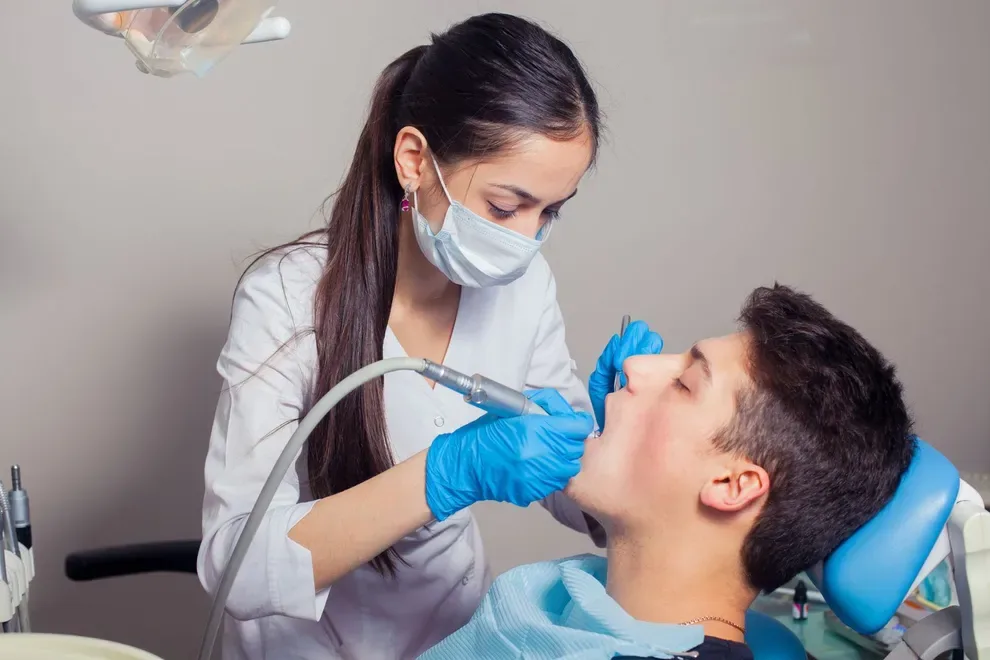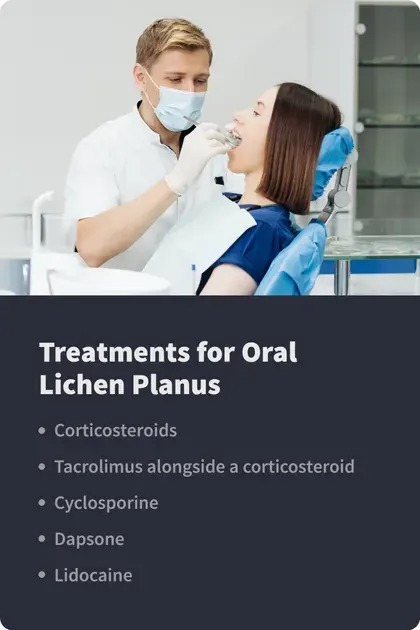Oral Lichen Planus: Causes, Symptoms, Diagnosis & Treatment

Table of Contents
- What Is Oral Lichen Planus?
- Causes
- Symptoms
- Diagnosis
- Treatment & Prevention
- References
What Is Oral Lichen Planus?
Oral Lichen Planus (OLP) is a common chronic inflammatory autoimmune disorder that affects your oral cavity and mucous surfaces. It can cause significant pain when it reaches an erosive or ulcerative state and may result in painful sores that may cause eating difficulty and even affect your speech.
Medically, the condition results in damage or destruction of the cells at the base of the outer layer of your skin.
Oral lichen planus affects as much as 4% of the population and often strikes women more than it does men – especially middle-aged women.
A small percentage of people – about 2%, on average – who encounter chronic, severe OLP also see it later develop into some type of oral cancer.
The symptomatic appearance can look similar to other conditions, presenting as blisters, erythema, erosions, white striations, and white papules or plaques. You will need a scalpel biopsy to get an accurate diagnosis, even in asymptomatic cases. Initial detection usually happens at your dentist’s office.
There are two primary forms of OLP – erosive and reticular.
Causes of Oral Lichen Planus
Medical professionals don’t know the exact cause of OLP, but anecdotal evidence suggests the use of dental materials and oral medications could cause it.
The disease isn’t contagious, so you can’t pass it to another person even if you share food or saliva (through kissing). Like its causes, the long-term risks from having this condition are also unclear.
The disease often begins when the immune system tries to fight off cells it thinks are problematic. This is the same basic immune response your body would have against a virus or germs.
Because OLP has no determined cause, its makeup isn’t rooted in other major immune disorders or issues.
Symptoms of Oral Lichen Planus
OLP’s symptoms vary from person to person. Even people dealing with it more than once may not experience the exact symptoms every time.
Symptoms of Reticular OLP
Reticular is the most common type of OLP and is usually asymptomatic. Common symptoms include:
White patches inside your mouth often described as a net or lace-like pattern with wart-like (keratotic) lines and texture you can feel with your tongue.
You may also experience keratotic papules interconnected by thin keratotic lines or ridges (striae). Alternatively, they may be single or multiple plaques without the striae.
Lesions often flare up for no apparent reason and disappear without any medical intervention.
Symptoms of Erosive OLP
Although less prevalent, Erosive OLP is the more severe of the two types. It often presents the same symptoms as reticular OLP, and the two can even occur simultaneously.
Some patients report that they initially feel they may have an oral infection when they notice the symptoms later diagnosed as oral lichen planus. Many patients report symptoms such as:
Open sores typically accompanied by more mild symptoms like white patches
The affected mucosal zones will display signs of erosion or ulceration, and tissue wasting away (atrophy)
Patients will find brushing or flossing uncomfortable or painful
Severe pain can interfere with speaking or normal eating (mastication)
On rare occasions, erosive OLP may be so severe as to cause the skin to separate and form blisters or sacs containing fluids (bulla or vesicle)
Like reticular OLP, erosive OLP does not necessarily get progressively worse over time. Its development can fluctuate – get worse and get better. It also can dissipate fully.
Getting Diagnosed
To get a diagnosis of either type of OLP, your doctor will perform an in-depth visual examination of your mouth, looking especially for lesions.
If the doctor suspects you have OLP but can’t confirm it through clinical appearance, the best way to verify is to get a clinical diagnosis through a clinical and histological exam, which scrutinizes tissue under a microscope.
These lab tests will confirm OLP or else send you and your doctor looking in another direction. In some cases, your dentist may be able to spot OLP and send you to a doctor for a thorough evaluation.
Treatment and Prevention

There are various options for treating OLP, including:
Corticosteroids may treat inflammatory disorders in the mouth and throughout the body.
A prescription of Tacrolimus alongside a corticosteroid may prove effective for oral lichen planus patients. This combination treatment is commonly prescribed for organ transplant patients.
A prescription of Cyclosporine, an immunosuppressive drug that doctors use for psoriasis and rheumatoid arthritis treatment. It, too, is a medication commonly recommended for transplant patients.
A prescription of Dapsone, a common antibiotic and anti-inflammatory medication. It is used to treat certain types of dermatitis.
Lidocaine can help reduce pain in cases that don’t require more specific medical intervention.
OLP is typically a chronic disease that tends to flare up from time to time without warning and without any pre-conditions. Even patients who have success with medication may have recurrent symptoms.
That means there’s no specific prevention routine that can help you with oral lichen planus. Using medication prescribed by your doctor correctly is the most effective way of managing OLP.
Eating a variety of healthy foods, including fruits and vegetables, and drinking plenty of water may also be helpful. However, this may have more to do with reducing your body’s inflammatory response than treating OLP.
Seek medical attention from a physician whenever you suspect you have OLP. They’re familiar with the disorder and ready to help.
Don’t hesitate as severe oral lichen planus can worsen and leave long-lasting issues like eating discomfort, speech difficulty, and problems with caring for your teeth.
